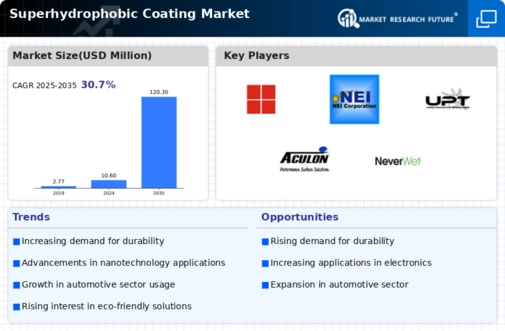Top Industry Leaders in the Superhydrophobic Coating Market
 Imagine a world where raindrops dance, not soak, where dirt vanishes with a gentle touch, and surfaces remain pristine under any weather. This is the magic of superhydrophobic coatings, a technology revolutionizing diverse industries and captivating the attention of a dynamic and competitive market. To navigate this thrilling landscape, we must delve into the strategies employed by key players, the factors influencing market share, the latest industry buzz, and the whispers of recent developments.
Imagine a world where raindrops dance, not soak, where dirt vanishes with a gentle touch, and surfaces remain pristine under any weather. This is the magic of superhydrophobic coatings, a technology revolutionizing diverse industries and captivating the attention of a dynamic and competitive market. To navigate this thrilling landscape, we must delve into the strategies employed by key players, the factors influencing market share, the latest industry buzz, and the whispers of recent developments.
Strategies for Repelling the Competition:
-
Product Diversification Deluge: Leading players like PPG Industries, Akzo Nobel, and Solvay are expanding their portfolios beyond traditional spray-on coatings to cater to niche applications. This includes self-cleaning textiles, anti-icing paints, and bio-inspired materials, ensuring a foothold in lucrative segments. -
Regional Ripples: Asia-Pacific, with its booming manufacturing and electronics industries, is a magnet for market expansion. Companies are establishing local production facilities, forging regional partnerships, and tailoring product offerings to specific environmental conditions, solidifying their presence in this high-growth zone. -
Innovation Tsunami: Continuous research and development are crucial for staying ahead. Companies like Dow Chemical and DuPont are investing heavily in nanotechnology and surface chemistry, aiming to create even more durable, efficient, and sustainable superhydrophobic coatings. -
Vertical Integration Vortex: Some players are integrating upstream (raw materials) and downstream (finished product manufacturing) activities. This enhances control over supply chains, optimizes costs, and provides a competitive edge by offering complete solutions. -
M&A Mergers: Mergers and acquisitions play a role in market consolidation. For instance, Covestro's acquisition of Bayer's polyurethanes business in 2018 strengthened its position in the superhydrophobic coatings market, particularly for high-performance applications.
Factors Shaping the Market's Tide:
-
Demand Drivers: The diverse applications of superhydrophobic coatings, from self-cleaning windows and stain-resistant fabrics to anti-fouling marine vessels and corrosion-resistant pipelines, drive demand. Growing environmental consciousness and technological advancements further fuel this growth. -
Regulatory Waves: Stringent environmental regulations, particularly in Europe and North America, are pushing for low-VOC (volatile organic compound) and bio-based coatings. This presents both challenges and opportunities for innovation. -
Cost Currents: The initial investment in research and development, coupled with the use of specialized materials, can pose challenges for market entry and scalability, particularly for smaller players. -
Durability Dilemmas: Long-term durability and adhesion of superhydrophobic coatings remain areas of concern, requiring continuous development and testing.
Key Players
Some of the key players in the global superhydrophobic coating market are P2i International Ltd (US), UltraTech International Inc. (US), Lotus Leaf Inc. (Mexico), Rust-Oleum (US), NEI Corporation (US), United Protective Technologies (US), Hydrobead (US), Aculon (US), NeverWet (US), Advanced NanoTech Lab (India), and Excel Coatings (India).
Recent Developments:
-
August 2023: A class-action lawsuit is filed against a major manufacturer of superhydrophobic coatings for alleged durability issues and environmental impact, highlighting the importance of quality control and sustainability practices. -
July 2023: A consortium of industry players and environmental organizations launch a collaborative initiative to develop and implement recycling systems for used superhydrophobic coatings, promoting a circular economy in the industry. -
June 2023: The first commercial application of superhydrophobic coatings in 3D printing is announced, opening up new avenues for custom-designed surfaces

